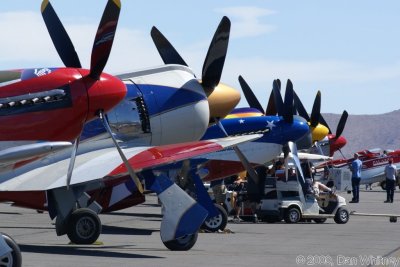
Reno 2009
The Unlimited Engines
by Dan Whitney
All Photos by the Author
 |
| Unlimiteds on the Reno Ramp Awaiting the Start of Qualifying |
We go racing to see fast airplanes in their natural element, enjoy their functional beauty, color, drama, and to see some good completion. Reno 2009 provided all of these and more. The racing was awesome, and for the first time in a number of years, the broken engines were all repairable.
The effects of the current economic recession were a concern to many, with the fear that a full field of racers might not be on the ramp and the grandstands not full. In the event there were a number of past racers missing, however most with very good reasons, but fortunately a number of new racers did appear. Even so, the Thursday “Medallion” consolation race was canceled, as there were just enough airplanes qualified to fill the 27 unlimited racing slots. The crowds in the grandstands reflected the good family entertainment value that air shows and air racing provide; attendance at the 2009 Reno event was up. Even with the limited field the racing competition was outstanding, resulting in a fun event for all, and even more so for those teams that were the winners.
Reno is not a just an air race, rather it is a happening, an event, a whole long week of sights and sounds! Some of the most intense competition occurs at the first of the week, with the qualifying sessions for all six racing classes spanning Monday through Wednesday. This article focuses on the “Unlimited” racing class, those racers that weigh more than 4,500 pounds, are powered by piston engines, and qualify at over 300 mph. These are for the most part WWII vintage fighters, with some of the airframes and engines extensively modified to allow average lap speeds that WWII fliers could only achieve in a “power dive”.
A number of substantive changes have occurred within the roster of unlimited racers during the past year. Soon after the 2008 races Michael Brown sold his entire stable of unlimited racers, including the R-3350 powered Hawker Sea Furys September Fury, September Pops, and the Grumman F7F Big Boss Man. His team was always very competitive, with one of the legends of crewchiefing, Bill Kerchenfaut presiding, and with an airplane capable of winning each of the Gold, Silver, and Bronze classes. All of the airplanes were sold to Rod Lewis of Texas, who already was fielding the perennial favorite; the highly modified R-3350 powered Grumman Bearcat Rare Bear, crewchiefed by Dave Cornell. Lewis only brought Rare Bear to the hunt this year, so the missing Brown airplanes were one of the reasons for the lesser number of racers.
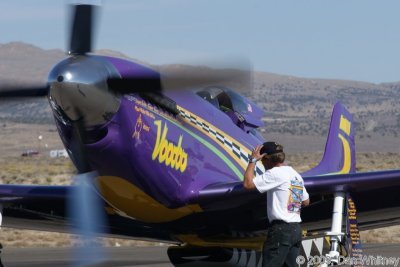 |
| Crewman Mike Wilton greeting Voodoo and pilot Will Whiteside back after qualifying at 446 mph. |
With Kerchenfaut and his guys uncommitted they sought out a new racer and found the R-4360 powered Sea Fury Furious to be an appropriate recipient of their considerable talents. They started to work on their new airplane soon after Reno 2008, and then determined it needed a complete airframe and engine overhaul to remove effects of corrosion and fatigue brought on by many years of campaigning. This effort exceeded the amount of time available to prepare the airplane, so it took a bye in 2009. Kerchenfaut and team then joined with the Voodoo crew and worked hard to keep the competition honest with yet another very fast airplane.
A past Unlimited Gold winner and longtime exciting competitor Dago Red was missing from this year’s competition; the consequence of a change in ownership this past May while the racer was torn down for a much needed complete overhaul. As a result it missed the races this year. This left last year’s Dago Red race team, headed by its pilot Dan Martin and featuring a full race Merlin from Mike Barrow’s Air Sparrow, without a racer. Not to be denied, Dan substituted his stock P-51D Ridge Runner III. He and his team then turned the airplane into the fastest “stock” P-51 ever seen on the Reno-Stead course! They did this by fitting “bolt on” modifications that resulted in wings clipped at the outboard production joint, with shortened ailerons, then fabricating and fitting a streamlined radiator exit door/chute, and a new rudder without the “prone to depart the airplane” trim tab. They also installed elongated trailing edge strake fairings and a borrowed canopy having a slightly lower profile. Not obvious to an observer, they also sealed up the forward cowling to minimize entry of drag producing air into the engine compartment. Then they installed a revised radiator scoop similar to the one on Dago Red, which has a reduced inlet area (results in less drag due to air brought on-board). They also eliminated the air going to the oil cooler, and streamlined the airflow into the coolant radiator. A P-51H type liquid-liquid oil cooler connected to the engine coolant system provided oil cooling. Up front they installed the powerful Air Sparrow Merlin, and were ready to go racing!
All week we were expecting another new racer on the ramp— The Galloping Ghost. This racer, from the old Cleveland races of the 1940s, is now owned and will be campaigned by the legendary race pilot Jimmy Leeward. The team appeared to be well organized and supported, but the project just took more time than was available. The magnitude of the endeavor was extensive, not only assembling the airplane for the first time in more than 20 years, but also modifying it to remove the coolant radiators and install an ADI “boiler” system in its place. The powerplant was a newly built racing Merlin out of Rick Shanholtzer’s shop. Because of the limited range of a “boiler” airplane, final assembly was done in Minden, Nevada, 40 miles south of Reno. Unfortunately the amount of work required exceeded the available time, and even with the approval by the Reno Air Racing Association to show up after the official close of qualifying, they were not able to make their first test flight until the day after Sunday’s Unlimited Gold race. This is a very historic and exciting airplane, and one that should be very competitive at future Reno’s.
Adding to the uniqueness of this year’s races was the appearance of racing Curtiss P-40s, for the first time since 1995. John Paul brought his P-40E and P-40N, which gave some very dramatic views as they rounded the pylons, often together. In addition Gerry Gabe’s Allison powered P-51A Polar Bear was in some of the same heats, so there were three Allison powered racers in competition, interestingly, all were using the late model P-38L V-1710-111 engine, not the models that were original to the airframes.
As usual the Sea Furys and slightly modified stock P-51D Mustangs filled the bulk of the Silver Class, which results in some fine racing of big, colorful and noisy airplanes. But the talk of the week was the highly modified Gold racers. Each of them had dramatic stories unfold during the week.
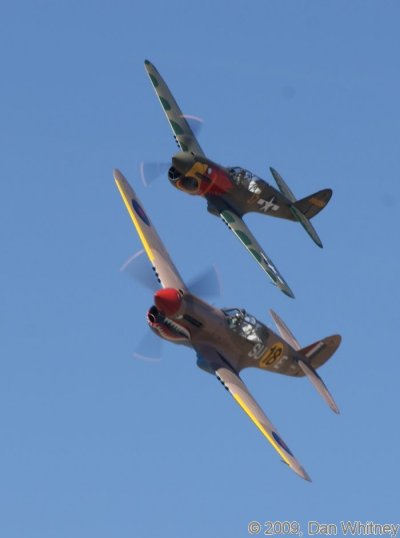 |
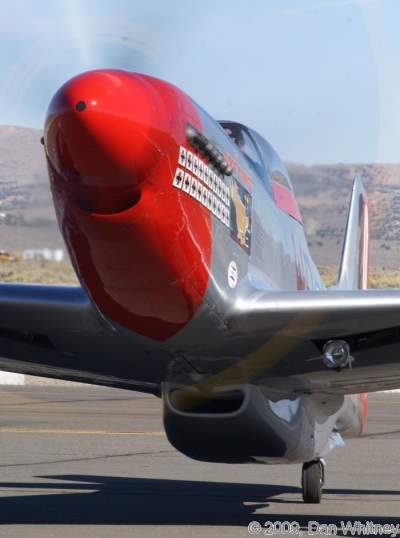 |
| #18 Sneak Attack, a P-40E piloted by John Maloney leads P-40N #17 Parrothead flown by John-Curtiss Paul in Friday’s Bronze Heat. | Good view of the very smooth, and smaller, new air scoop for the radiator on Dan Martin’s Ridge Runner III. Note that the boundary layer splitter on the stock Mustang is not used, and this one goes faster. |
Stories of the Week
Steven Hinton, 22-year old son of air racing legend Steve Hinton (who in 1979 set the piston driven world speed record at 499 mph in the Griffon powered RB-51 Red Barron, and then suffered a magneto condenser failure, which lead to failing a supercharger bearing at that year’s Reno and was injured in the resulting crash landing), was now the assigned pilot for Strega, a highly modified P-51 and a favorite to repeat as this year’s Gold winner. This very capable young pilot also was a primary member of the airplane’s engine crew and could be found between races with grease on his hands checking the engine over and setting the valve lash.
Bob Button’s Voodoo is another highly modified P-51D airframe powered by an Allison rodded Merlin. This year’s engine was built-up by long-time Voodoo crewman Frank Young with support by Jack Hovey; a testament to his work is the way the airplane stayed in the chase all week. Will Whiteside, who previously piloted his Silver Class racer Steadfast, flew the airplane, but it was his first outing in the competitive Gold Class. Steadfast was another of the past racers that was not a participant this year.
None of the racers create crowd and fan excitement the way Rare Bear does. A long-term racer and crowd pleaser, probably because it is usually the airplane for the Mustangs to beat; Rare Bear showed up with an awesome new paint job and a drag reducing ADI boiler to cool the engine oil. Crew chief Dave Cornell says this is the lowest drag configuration ever for the Bear.
Dan Martin and his “super stock” P-51D Ridge Runner III played the roll of Cinderella this year. Without access to Dago Red, he just would not be counted out. He had not only made the Mustang competitive, but then suffered burned pistons that required a Herculean effort by his crew to repair. And then he posted lap speeds that would have won the Gold in 2008. Quite an accomplishment: applauded by competitors and fans alike.
Strega set a new record for the fastest average speed ever for the Gold Final on the 8-lap 67-mile long course of 491.822 mph, breaking the previous record set in 2003 by Skip Holm in Dago Red, 487.938 mph.
Dave Morss completed his 200th race at Reno while flying P-51A Polar Bear in Saturday’s Silver Heat race. This puts Dave well ahead of all of the other competitors and demonstrates his piloting and racing skills as he has competed in five of the six racing classes, Bi-planes to Jets, everything except T-6s, all dating back to 1981!
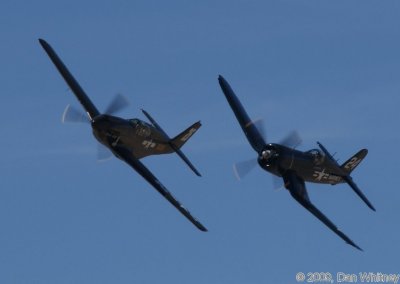 |
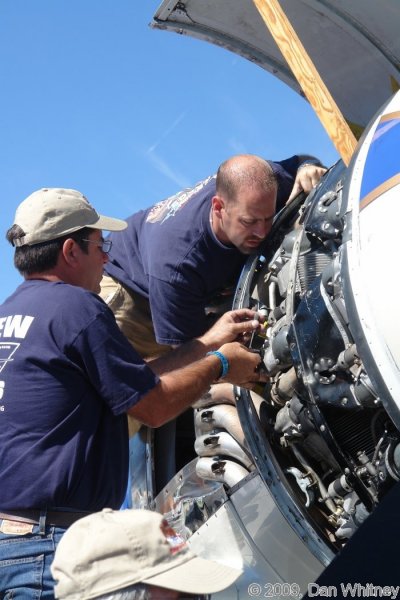 |
| Dave Morss piloting #25 Allison powered P-51A Polar Bear passing Doug Matthews in the #24 P&W R-2800 powered F4U-4 Corsair during Thursday’s Bronze Heat. | Spirit of Texas crew adjusting exhaust pipes on the R-3350. |
The Engines
In our limited space it is not possible to give a comprehensive description of what it takes to make an engine capable of running at Reno. Furthermore, not everyone is willing to talk about “all” of the details, yet there are some “typical” modifications and improvements, particularly for the Merlins and R-3350s, that provide a baseline for understanding where the “racers edge” comes from.
Categorically the “stock” airplanes run their regular engines, without any changes, other than making sure that they are in good tune. It might be surprising to realize that many of the stock racers are running at power settings shown in the operating manuals as “100% Normal Power”, at least for much of the race. However, on qualifying day they will probably run one lap at “takeoff” power. For the “stock” airplanes that decide to “go for the win”, they may step up the engine speed a little and see what happens. These airplanes typically do not have, or need, ADI (water injection) for these power levels, although it is not unusual for them to step up the fuel grade to 115/145 instead of 100LL, just as insurance.
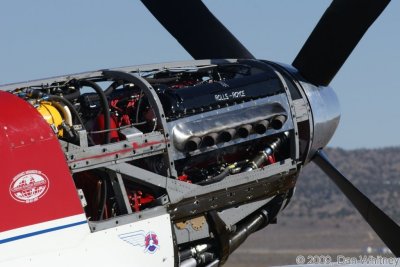 |
| Representative of Gold Class Mustangs, Strega’s Merlin engine compartment features carbon fiber cowling formers, the red tube, identifying this as a “tube” engine (that is without the aftercooler) and automotive style ignition harnesses. The internal changes are of course not visible. |
The Air Sparrow Merlin in Ridge Runner III this year has most of the features available within the Merlin contingent, and some that others can only dream about. The bottom of this engine, including the crank, oil pan, wheelcase and blower are from the Packard V-1650-9, however it has been fitted with Allison G6 connecting rods. This results in a very strong Merlin able to sustain both high rpm and manifold pressures. The crankcase, heads, banks and nosecase are from the Rolls-Royce Merlin 600/700 series of “transport” engines used post-war on the Canadian DC-4M airliners. The aftercooler used on the stock “two-stage” Merlin has been removed with a simple “tube” taking its place, along with an ADI system able to spray copious amounts of water/alcohol into the supercharger to keep the mixture temperature within limits. Custom lightweight 6.7:1 pistons (versus standard 6.0:1), modern piston rings, and slower speed reduction gears (0.400:1 versus 0.479:1 on Packard engines, although many of the racers use 0.420:1 gears from transport engines) are fitted. Custom made supercharger drive step-up gears cause the supercharger to run at an efficient speed. The result is an engine able to run a lower propeller speed (important when the airplane is flying 500 mph) while having the crankshaft running near optimum speed for bmep, while reducing the power consumed by the superchargers.
In contrast to the Merlin, the radial engines show far less development for racing. The most apparent modification is to fit a larger displacement engine than what was original to the airframe. In fact, of this year’s 13 radial-engined airplanes, only the #14 F8F-1 Bearcat and #24 F4U-4 Corsair, had their original type engines, those being the P&W R-2800, however they were not running the original models (dash numbers) appropriate to the airframes. The Sea Furys are all running late model Wright R-3350s or P&W R-4360s in place of their original 3,270 cubic inch Bristol Centaurus sleeve valve engines, the changes having been motivated primarily by performance, availability and cost. By proper selection of the power section, reduction gears, and supercharger there is some degree of performance improvement that these American engines can provide. By running them above rated takeoff rpm, the addition of ADI, and the use of racing fuel, there is some improvement in available power. Internal changes to pistons, rings, valve timing and other technical improvements are not usually incorporated. Dave Cornell, crew chief on Rare Bear developed a package of modifications for their R-3350 that turned it from a freight hauler to a racer. To the late model 18-cylinder power section, without the power recovery turbines, he fits the accessory section and two-speed supercharger from the R-3350-93 turbo-compound engine used in the EC-121 airplane. To slow the propeller at high airspeeds he uses the slower 0.355:1 reduction gear from the R-3350-EA-2 in the 1956 vintage Lockheed L-1649A Super Constellation airliner. He has also adapted the engine to use a carburetor in place of the direct cylinder fuel injection pump on the –93 and –EA-2. This package can deliver over 4,000 horsepower when running at 3,200 rpm and 80 inches manifold pressure. This is a considerable improvement over the original 2,800 hp available at 2,600 rpm and 45 inches of manifold pressure from the non-Turbo-compound engine. This engine is also fitted with nitrous, which can provide 4,500 hp for the full length of the race.
To give a sense of the drama in the pits, the following items reflect some of the issues confronted and resolved by the crews during the week:
Tuesday, 9-15-2009
#20 Ridge Runner III – Did it’s qualifying lap running 3,400 rpm and 110 inches. Dan felt a “bump” after pulling off the course at the end of the run. When he pulled off the power at touchdown there were about three seconds of white smoke from the right bank. He did a mag check at 2,300 rpm and all was well. After shutdown they did see oil in the A1 exhaust port, so they did a compression check and got nothing on A1 cylinder. The bank was pulled and the A1 piston was found to be burned, with signs of distress on the others. While no issues were externally apparent on the “B” bank, it was lifted as well since its pistons had all “been to the same dance”. While not as severe, some ring and piston scuffing was evident.
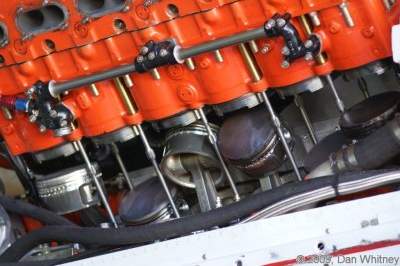 |
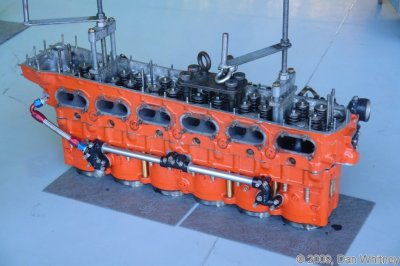 |
| Ridge Runner III right bank. The number one piston is burned, note the black exhaust port and the condition of the other pistons. | |
Engine builder Mike Barrow and another team member left Reno with the banks that night for his shop in Hollister, CA were the banks were rebuilt. Since a new package of rings and pistons had been used it was decided to install the pistons used in last year’s Dago Red engine, along with new rings, in the reworked cylinder bores. The valves also were cleaned and reground as some had molten aluminum residue from the pistons welded to them. Furthermore, the banks had to be trued to remove the effects of overheating. After 48 hours of work and travel the banks were back in Reno, installed on the engine, and the engine run for the first time Thursday evening. After seating the rings a test flight on Friday morning confirmed that all was well and the airplane was ready for the first day of Gold competition. The team believed that the problems were due to several cylinders that seemed to have run excessively hot, hence the decision to return to the previous year’s piston/ring configuration. The rest of the week the engine ran perfectly, followed by an uneventful cross-country flight home across the Sierras after the races.
#7 Strega – This race Merlin is unique in that it has steel main bearing caps and has been reworked to make it more reliable. With these changes the engine has operated at high manifold pressures, giving high flow through the cylinders, which develops the full measure of thrust from the ejector exhaust nozzles. The configuration obviously works as the airplane has won Reno Gold now two years in a row. Pilot Steven Hinton reported that when he first took the airplane to power he ran a lap at 80 inches, and was impressed by the speed increase over the Merlin's usual maximum power of 67 inches. He then took it up to 100 inches, and was not impressed with the speed increase, however that changed when to went to 3,400 rpm and 120 inches! The speed jumped up, and he qualified the airplane at 486.170 mph.
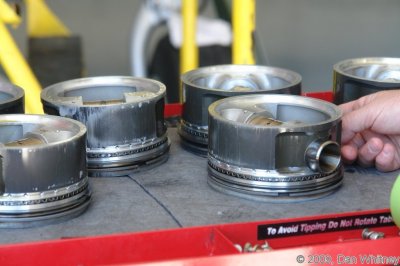 |
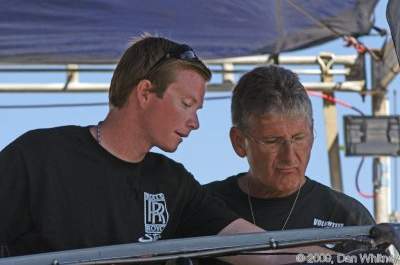 |
| Ridge Runner III left bank pistons. All show some distress and were replaced with the pistons that were in this engine when it powered Dago Red in 2008. These pistons are typical of those being provided by Jack Roush Enterprises in that they are lighter than original Merlin pistons, have all of the rings above the wrist pin, and include an antifriction coating on the skirts, and a ceramic protective coat on the crown. | Steven Hinton showing his Dad the valve rack they are changing on Strega after he qualified the airplane at 486.170 mph. |
Wednesday, 9-16-2009, Final Day of Qualifying
Up and down the pits the crews are working to sort out a thousand details. #105 Spirit of Texas has some loose induction pipes, #99 Riff-Raff is sorting out some magneto problems, and #5 Voodoo is changing the ADI metering orifices in anticipation of high ambient temperatures the rest of the week.
The Allison powered airplanes, P-40N #17 Parrothead, P-40E #18 Sneak Attack, and P-51A #25 Polar Bear, are all running V-1710-111 engines. Their maximum power at qualifying speeds here at Reno, 5,000 feet elevation, is 3,000 rpm and 51 inHgA. During the races they tend to run at reduced power, except when the urge to pass, or keep from being passed, hits them. It is interesting to compare the resulting lap speeds.
#7 Strega – Post qualifying inspection found one of the stellite pads on the “Merlin Fingers”valve actuator had come off. All day was spent replacing the assembly, no damage was done.
#77 Rare Bear – Qualified at 402.678 mph running a nearly stock Skyraider R-3350. Power was 1,830 hp with 2,800 rpm and 48-50 inches. The Bear has been in its “lair” most of the week while the team sorted out issues with the newly installed “boiler” oil cooler system. Performance was erratic and it was first thought to be plumbing and piping related, then a small quantity of oil was found in the boiler. The problem was foaming caused by oil leaking into the boiler, which necessitated replacing the heat exchanger. Once this was done the issues were resolved. The first flight on the new cooler was during Friday’s Gold Heat. The engine has also been an issue as last year’s hybrid “race” engine is in need of new main bearings. At first they thought they could use the race engine from the ex-Michael Brown September Fury, but when it was inspected internally rust was found, along with failing components in the supercharger drive. They had two other engines in the hangar, but they could only provide parts, so the decision was made to use a stock R-3350-26WA from a A-1E Skyraider and see what a really slick airframe could do.
#105 Spirit of Texas – During qualifications the R-3350 powered Sea Fury team was frustrated that its posted speed of 430 mph was about ten mph low, yet the airplane seemed smooth and fine. On the last day of qualifying pilot Stewart Dawson took it up to see if the missing speed could be found in a requalification attempt. During the run he felt some vibration and heard a loud “pop”, he immediately pulled the power back, maydayed, and landed safely. The post-flight inspection found the number 13 piston burned, so Spirit of Texas was out for Reno 2009.
Thursday, 9-17-2009 – Unlimited Racing Starts Today!
Brant Seghetti has decided to not race his Mustang #44 Sparky, which he had qualified at 344.623 mph, as it has had a vibration since the engine was installed prior to coming to Reno. After all sorts of checking and balancing they have not been able to resolve it.
#5 Voodoo – After yesterday’s flight a 1A intake valve would not seat, and could not be lapped, so the team took the bank to Jack Hovey in California for reworking. It will be run Thursday evening. It’s a good thing that the Gold racers have a bye on Thursday, for several need the extra time to resolve the gremlins!
#7 Strega – During an evening test flight Hinton noticed that the oil pressure was bouncing around and dropping, he executed an emergency landing and the crew found that a plug in the supercharger oil supply was loose. The screens were clean, but they were not really sure of the engines condition until after the Friday race. All was well.
#14 Bearcat – During the first lap of the Silver Heat race the engine began running rough and pilot/owner Howard Pardue returned to the pits. They found that the center electrode tip on one of the plugs had completely broken away, and fortunately welded itself across the terminals on the other plug. The debris had not damaged the cylinder, piston or valves. A pair of new plugs and the Bearcat was in the hunt for the rest of the week.
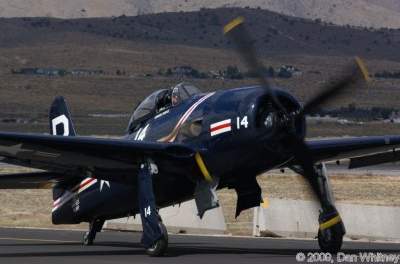 |
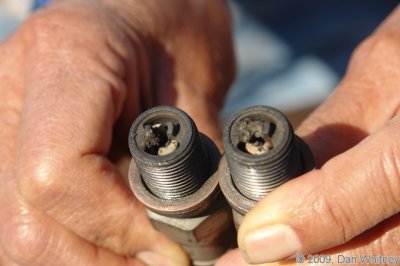 |
| Here are the plugs from the bad cylinder that caused Howard Pardue to pull his #14 Bearcat out of the Thursday Silver Heat. Fortunate that the failed electrode did not do internal damage to the cylinder. | |
#25 Polar Bear – The Allison-powered Mustang and both P-40s were in the Bronze Heat. Dave Morss reported that he was able to stay with them, while they were running maximum power, by running 2,600 rpm and 35 inches. He did run one lap at 3,000 rpm and 50 inches to pass the Corsair. This says a lot about the clean P-51A airframe.
#77 Rare Bear – Finished 2nd in the race using the engine’s maximum “dry” (no ADI) power rating. This was done because of concerns about the repiped ADI supply to the “boiler” oil cooler. The engine ADI system was configured as a backup, and therefore not available to the engine. After the race #99 Riff-Raff was disqualified for pylon cuts, so theBear was given the win, at a speed of 412.230 mph, 10 mph faster than his qualifying speed.
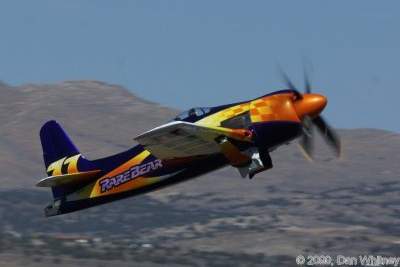 |
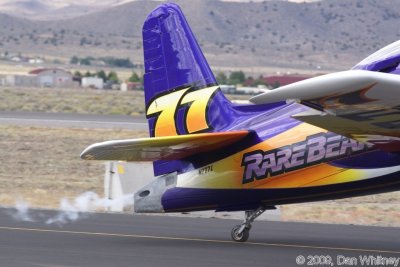 |
| #77 Rare Bear is sporting a new drag reducing “boil-off” oil cooling system, hence the vapor from the water/alcohol being vented from the tail cone. | |
Friday, 9-18-2009
Not very much going on in the pits, the airplanes are all buttoned up and polished, ready for a day of racing.
The Unlimited Bronze race provided some good close competition, with three “pairs” of airplanes mixing it up. P-51D Mustang #52 American Beauty was running 3,050 rpm and 60 inches when easily passed by the P-51A #25, who was running 3,000 rpm and 51 inches; Again a testament to the P-51A’s clean aerodynamics. After the race the American Beauty crew determined to adjust the engine governor so that they could run 70 inches. You can see the competitive spirit building throughout the pits!
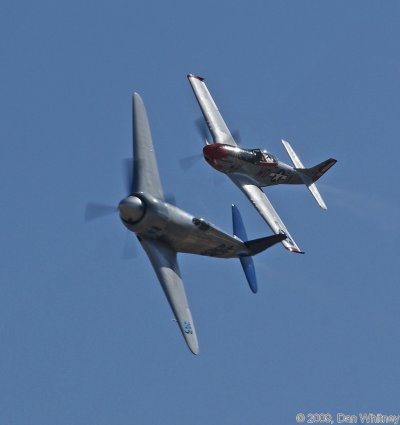 |
| Dan Martin in Ridge Runner III catching Sherm Smoot in his #86 R-2800 powered Yak-11 in Friday’s Gold Heat. |
Saturday, 9-19-2009
#77 Rare Bear – Things are coming together for the airplane. All of the systems are working, the ADI has been reconnected to the engine, and they were able to show some of their potential with the “stock” Skyraider R-3350. They ran rated wet takeoff power of 3,000 rpm, 60 inches, and 3,000 horsepower, enough for a 4th place finish in the Gold Heat at 471.500 mph.
Sunday 9-20-2009
They pretty much go for broke today. Just look at the tabulated results below to see that there was some really good racing on this the final day of Reno 2009. All week the Heat races had been six laps of the Unlimited Course. Today the Bronze remained six, but the Silver is seven, and the Gold eight laps. With this format each of the Heats lasts 8 to 9 minutes, which is a very long time considering the speeds, power settings, and closeness to the ground.
#52 American Beauty – If there was any question about the effects of manifold pressure just look at the summary table at the end of this article. #52 ran all week at speeds in the range of 314 – 325 mph using 61 inches, and then with 70 inches available, was able to win the Bronze Heat with a speed of 363.235 mph! Nice going guys!
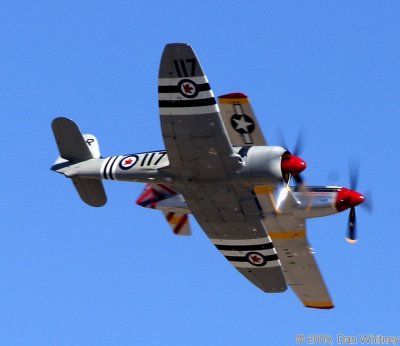 |
| Fred Cabanas in his #52 Mustang American Beauty trying to pass the #117 Sea Fury Bad Attitude and win Sunday’s Bronze race. Fred ended up 1.5 seconds behind at the finish, even though he was running 70 inches! His attitude changed when Doug Matthews forfeited the win and bumped Bad Attitude up to race in the Silver. |
#7 Strega – With Saturday’s pylon cut Voodoo was on the pole and Hinton’s intent was to pass her on the first lap. As it developed Strega was able to pass at the start, and from there never looked back. Hinton reported that he had not pushed the engine all week, because they felt there were no major competitors. He flew a somewhat wider line on Sunday to assure that there would be no more pylon cuts, and by the second lap he had backed the power off quite a bit and still continued to outdistance the field, and even lapped the last place airplane. The result was a new record speed for the Gold Final of 491.822 mph, not bad for your first outing in a Gold Class racer!
#5 Voodoo – That Strega was able to slip in front of Voodoo on the start was a surprise, with the result that Voodoo was chasing the leader all of the way, and appeared to be closing the gap. On lap 2, just past Pylon 2, Whiteside hit Strega’s prop wash and was thrown a couple of hundred feet up. Whiteside never flinched, just righted the airplane and continued on the course. Then on Lap 6 the engine began to smoke, he pulled off the power, climbed for altitude, lined up with the emergency runway, touched down and rolled out safely. Excellent airmanship!
After the race the problem was found to be a “burned piston”, but not due to the usual causes. The piston was one of the new lightweight types and a portion of the land above the top ring had broken off, which resulted in burning the piston and the smoke. A number of cracks were found in the top land area of this piston, but the other pistons in the engine had none. It appears that this was an isolated failure, possibly due to a forging or manufacture defect. The engine will be back at Reno next year.
#20 Ridge Runner III – During the Saturday and Sunday races the team was frustrated that they were not able to get the expected manifold pressure of up to 135 inches. Only after getting home did they find that the carbon fiber ram air intake duct was cracked and opening up at high speeds. This spilled high-pressure ram air into the engine compartment and reduced the available manifold pressure. By Sunday’s race they were missing about 15 inches of manifold pressure, equivalent to about 300 horsepower.
#77 Rare Bear – Finished 2nd in the final, posting a speed of 479.088 mph using 3,200 horsepower from the “stock” R-3350.
Summary
Highlights of the week are the safe and outstanding racing, excellent racing weather, wide range of competition, and very colorful and powerful airplanes. In addition there were a lot of wonderful individual contributions to the success of the week. These include:
Twenty-two-year-old Steven Hinton, not only winning the Gold in Strega, but also establishing a new record race speed for the final of 491.822 mph. Interestingly, Steven not only became the youngest pilot to win Reno Gold, but he took that record from his father, who was 26 when he first won Reno Gold.
Dan Martin bringing his stock Mustang up to Gold standards, qualified 3rd at 454.605 mph, finished Saturday’s Gold with an average of 477.809, with one lap at 489 mph! Even with a split ram air duct on Sunday he finished the Gold race in 4th at 457.927 mph. Given that after qualifying on Tuesday a couple of burned pistons were found, which necessitated a complete overhaul of both banks, Dan and Ridge Runner III were a Cinderella story and a crowd and Pit Rat favorite all week.
A report like this necessarily cannot detail all of the events, incidents, and contributions made by the racers, participants, fans, and the Reno Air Racing Association that annually produces a world class and premier aviation event. All are to be congratulated for their rolls in making this year’s Reno Air Races a success.
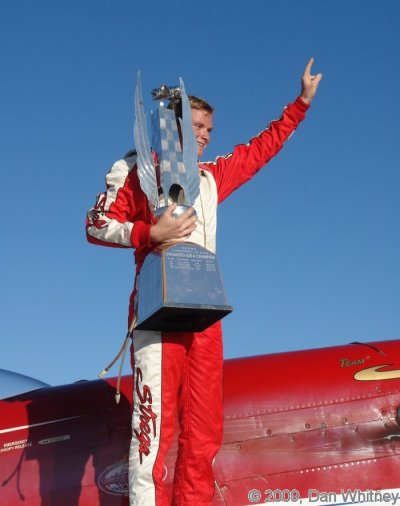 |
| Steven Hinton after piloting Strega to the Breitling Unlimited Gold win. The win capped a brilliant week in which he set a new record of 491.822 mph for the final race, and became the youngest winner ever. |